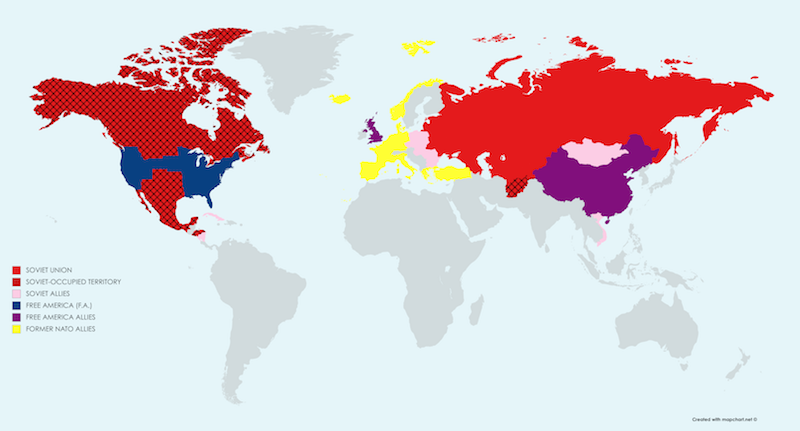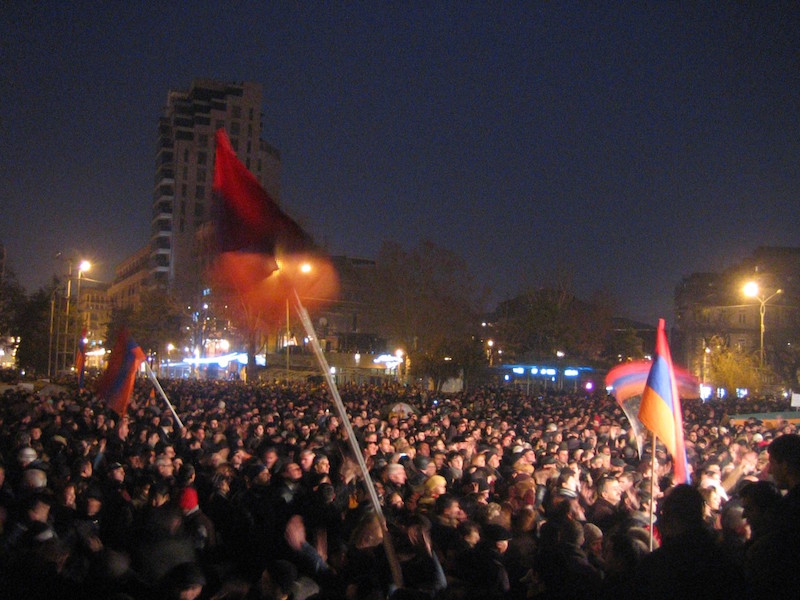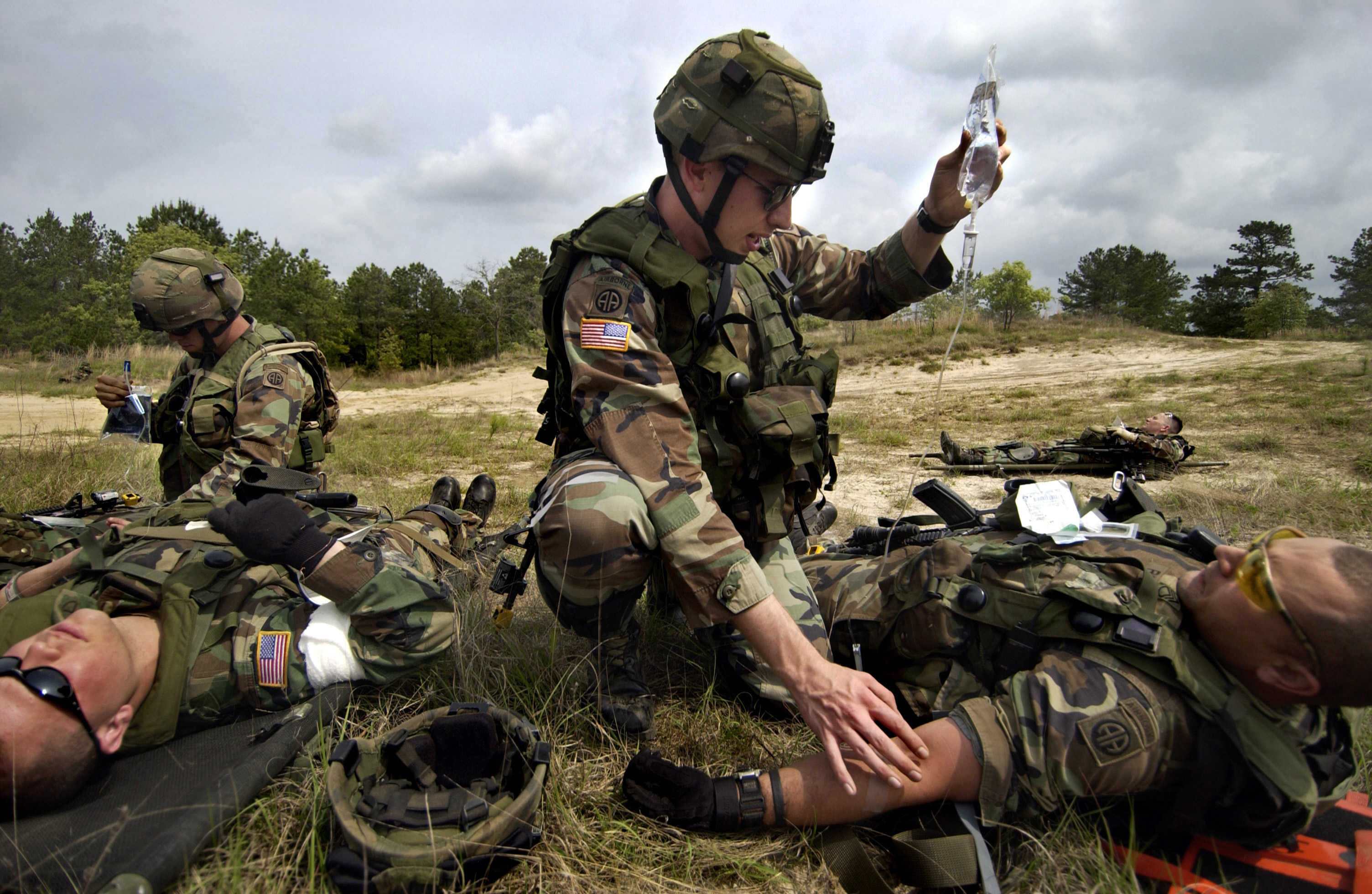Warning: This analysis contains spoilers.
A Film of the Reagan Years
If any film immerses the viewer in the geopolitical mood of the early 1980s, it is Red Dawn (1984). With the exception, perhaps, of the Cuban Missile Crisis, this was the period of the Cold War when direct military confrontation between the United States and the Soviet Union appeared most likely. This climate was the source of considerable popular anxiety, which was based on the public’s only partial access to information on just how dangerous relations had become between the two superpowers. The deterioration in the international situation in the early 1980s was the product of a number of structural and personal developments. On the one hand, mounting economic difficulties beset the USSR, coupled with growing unrest in Soviet-dominated Eastern Europe generated by the Polish “Solidarity” movement, all of which made Moscow feel increasingly vulnerable. On the other hand, newly elected U.S. President Ronald Reagan’s blistering anti-Soviet rhetoric and the introduction of new nuclear missiles to Western Europe made the Kremlin paranoid that Washington was contemplating a nuclear first-strike. To many people at the time, it appeared as though World War III was imminent.
Red Dawn imagined what the Cold War would look like if it turned “hot” by conjecturing plausible developments in 1980s international affairs that lead to war between the two superpowers. While the plot of the movie mostly centers on the actions and experiences of a small group of young adults caught in the middle of the conflict, the narrative often steps back far enough to afford the viewer a panoramic view of this hypothetical World War III scenario. As time has passed, many of the nuances of Red Dawn that would resonate with a viewer in the early 1980s are probably lost on contemporary audiences. Therefore, this analysis will attempt to fully educe some of the subtler points of the film.
The Story and Its Relevance to 1980s Geopolitics
Red Dawn has an unusually abrupt and ominous beginning. The first screenshots contextualize the film’s plot with text appearing against a black backdrop, set to eerie music, narrating some of the geopolitical developments in this fictitious early-1980s world that have led to the isolation of the United States on the world stage. First, the viewer learns that the Soviet Union has suffered its worst wheat harvest since the disastrous collectivization program of the 1930s, causing widespread social unrest in the Soviet bloc, especially in Poland. In this fictionalized scenario, Soviet troops intervene, much like they did in Hungary in 1956 and Czechoslovakia in 1968, eliciting no apparent response from NATO. Meanwhile, in Nicaragua, the communist Sandinistas have seemingly defeated the Washington-backed “Contras” for control of the country and aligned it with Fidel Castro’s Cuba, forming a highly militarized communist bloc in the Americas. Revolution spreads to the rest of Central America and Mexico, effectively arriving at the United States’ southern doorstep. In Germany, the Green Party forms the government and plays into the Soviets’ hands by campaigning for the denuclearization of Europe (in the context of the 1980s, this would likely mean the removal of the Pershing II intermediate-range missile introduced by the United States, perhaps the most effective deterrent in the NATO arsenal at the time, and a contentious issue in Europe), practically neutralizing the Allied threat to the Soviet Union’s western flank. The viewer is told that NATO has “dissolved,” and that now the “United States stands alone.”
The screen subsequently pans to a first-person point-of-view (POV) of flight above the clouds, set to dreadful music, as credits are introduced. Much like the opening montage of Jaws (1975), which features the POV of the shark cruising along the ocean floor unbeknownst to his would-be victims, this screen shot suggests the coming of Soviet airborne units. The viewer is then treated to an idyllic picture of small-town Americana, the fictional community of Calumet, Colorado. In the centre of the town stands a statue representing one of Teddy Roosevelt’s “rough riders,” featuring a quotation from that president’s well-known speech, “The Strenuous Life,” in which he emphasized the linkage between individual masculine virtues and national security: “Far better it is to dare mighty things than to take rank with those poor timid spirits who know neither victory nor defeat.” The idea that softness and complacency are a country’s undoing, but martial vigour revivifies the individual and the nation, is a common theme throughout Red Dawn.

Calumet is a fictional town located abreast of the Colorado Rocky Mountains (Photo by Rick Kimpel via Wikipedia Commons CC-BY S.A. 2.0)
It is a typical September day. Jed (Patrick Swayze), a young working man and former quarterback drops his brother, Matt (Charlie Sheen), and his friend, Arturo (Doug Toby), off at Calumet’s high school in his blue Chevrolet pickup. In a further emphasis on the quintessential Americanness of the town, the three boys exchange jibes about their school football team, the “Wolverines”, and its recent loss in a match on home turf. It is a foreshadowing of much greater ‘home’ losses ahead.
At school, the history teacher is relaying a lesson about Genghis Khan’s military tactics, particularly the Mongols’ encirclement of the enemy. The lesson is dramatically ironic because the United States, the prologue of the film makes clear, has become diplomatically encircled by the communist world. It also prefigures the ‘pincer movement’ Soviet and Latin American forces will use to try to envelope the United States with a two-front war (more on this later).
The teacher’s lesson trails off as he notices uniformed parachutists landing on the football field outside the school. Assuming they are an American airborne unit on exercise who have simply landed off course, he goes out to investigate, only to be shot dead by one of the parachutists, who can now be heard speaking Russian. These are not American paratroopers. They are Soviet Spetsnaz! What follows is a slightly over-the-top sequence in which the invaders randomly shoot up the school and send the students fleeing. Jed frantically drives his truck around the school parking lot looking for his brother. Matt and Arturo hop in, joined by three other escapees: Daryl (Darren Dalton), the student body president and son of Calumet’s mayor, Robert (C. Thomas Howell), whose father owns a supply store outside the town, and an innocent-looking sophomore, Danny (Brad Savage). The six flee Calumet, which is now engulfed with hordes of Soviet and, it turns out, Cuban troops and infantry-fighting vehicles, and make for Robert’s father’s general store. Jed is the natural leader of the group, and on his insistence the boys seek shelter in the Colorado Mountains.
In the mountains, the boys live off their supplies and the game they hunt. The viewer learns that Jed and Matt’s father taught his boys how to survive in the wild – an instantiation of the “rough rider” American virtues of readiness and self-sufficiency promoted by Theodore Roosevelt, which form part of the real-life U.S. “Survivalist” or “Prepper” subculture.
Aggravated by curiosity and lacking a working radio, three of the boys – Jed, Matt, and Robert – venture back into town after spending a month on the mountain with the other refugees. Their errand into Soviet-occupied Calumet becomes something of an Orwellian odyssey. At this point in the story, Red Dawn mimics the old 1950s McCarthyist films that sought to impress upon Americans the fear that “it could happen here,” in other words, that the United States was not secured from communist domination by its ocean flanks, a sentiment that crystallized in the Truman Doctrine. The young protagonists return to find that the Soviets have completely integrated Calumet into their political system. Communist authorities have plastered the town walls with agitprop in English and Russian, there is a “Soviet-American Friendship Centre” for disseminating propaganda, and the local cinema offers free admission to round-the-clock showings of Alexander Nevsky. Daryl’s father, the mayor of Calumet, is a quisling of the Soviet occupiers. The boys learn that the KGB took their parents to “re-education camp” as potential subversives, and they set out to find them.
The camp is located in the town’s former drive-in theatre. It’s a sad juxtaposition with the idyllic image of American life. Where Americans used to watch movies for pleasure, the Soviets now force inmates to absorb propaganda films, and loudspeakers incessantly denounce American history. Distraught family members line the perimeter, shouting to their imprisoned relations through the fence. Brothers Jed and Matt find their father (Harry Dean Stanton), who expresses satisfaction that he was stern with the boys and instilled in them the rugged skills that they will now need to survive their uncertain future. “One way or another…for one reason or another…. It’s all gone,” the father says of their traditional way of life. This introduces another salient theme running through the film: the tension between the innocence of youth, the need to shed that innocence in order to rise to the challenge of an unforgiving world, and the yearning for the restoration of that lost innocence. The father recounts taking the boys to the park when they were children, but those days, symbolizing the carefreeness of their youth and his paternal protection, are over. He forbids them to ever cry again, and sends the boys back to the mountains, sternly warning them not to return. The KGB is aware that the boys are missing from the town and is intent on apprehending them. On their way back to their mountain hideaway, they pick up additional refugees, two girls, Toni (Jennifer Grey) and Erica (Lea Thompson).
Riding out the rest of World War III in the mountains is not in the cards for the youths, however, as the occupation of Colorado brings groups of off-duty Soviet officers up the mountains on self-guided excursions. Encountering one such party, the teenagers kill the Russian officers, whetting their appetite for vengeance. Only Danny expresses mixed emotions about killing. The KGB surmises that the Soviet officers were killed by the missing teenagers from Calumet and carry out reprisal executions of their family members, including Jed and Matt’s father. This only deepens the teenagers’ hatred for the communist enemy. Becoming full-fledged guerrillas, the youths call themselves “Wolverines,” the name of their high school football team, and turn to partisan tactics against the communist forces moving through the mountain passes.
Autumn turns to winter, and the Wolverines cause the Soviets and their Latin American allies considerable trouble by constantly ambushing Soviet soft targets, depicted in a sequence of action-packed scenes. However, at this point in the story, the viewer still does not have a sense of how the teenagers’ private war fits into the overall picture of the war at large, or the most pressing question of all – what started the war in the first place? Fortunately, one day the Wolverines pick up an American fighter pilot who was shot down in a dogfight with Soviet MiGs. Huddled around the fire in the Wolverines’ mountain hideout, Colonel Tanner (Powers Boothe), provides a bird’s-eye view of the world at war, a panorama that has eluded the audience until this point. One logical question to have is, how could war have broken out between the two nuclear superpowers and not result in total human annihilation? Tanner explains that the U.S. nuclear deterrent was effectively neutralized by accurate Soviet ICBM strikes on American missile siloes and communication centers, including Washington D.C., Omaha, and Kansas City (also known as a “decapitation strike”), synchronized with sabotage carried out by Latin American infiltrators who illegally crossed the border from Mexico. Thus, there has been a “limited” nuclear war. This left the United States defenceless as the Cuban and Nicaraguan armies – each totally 500,000 men – invaded across the Rio Grande, making their way as far north as Cheyenne before U.S. conventional forces could stop them.

The Front Lines in North America as described by Colonel Tanner
Calumet, it turns out, was a critical Rocky Mountain pass along the invasion route, hence its seizure by Soviet airborne units at the beginning of the film. With the Cuban and Nicaraguan armies halted at Cheyenne, the Soviets have invaded across the Bering Strait into Alaska and have come south through Canada in an attempt to link up with their southern pincer and complete the Genghis Khan-like encirclement of the United States. Fortunately, Tanner explains, U.S. forces were able to stop the Soviet pincer, keeping a corridor of land connecting the East and West coasts. At this point, the communist invasion has stalled and now a conventional war between the two sides rages on across no-man’s land in the American West. However, large tracts of American territory remain under Soviet occupation, including Colorado. The rest of the country is colloquially known as “F.A.” or “Free America.”
For the most part, the United States is fighting alone. “What about Europe?” Robert asks. “I guess they figured,” Tanner suggests, “twice in one century was enough. They’re sitting this one out.” Only the United Kingdom is allied with the United States, perhaps out of a historical sense of obligation, but according to Tanner, Britain is already faltering. “Well who is on our side?” Jed despairs. “Six-hundred million screamin’ Chinamen,” Tanner replies sardonically. Apparently, China has taken the opportunity of war between the United States and the Soviet Union to settle old scores with the Russians. When Arturo interjects to say that he thought there were a billion Chinese, Tanner responds, “There were,” before flicking hard liquor on the fire for dramatic effect, suggestive of a nuclear conflict between the two communist giants that has annihilated forty percent of the Chinese population – a plausible scenario in the early 1980s. As for why the war broke out, Tanner can offer only a simplistic cliché: “Two toughest kids on the block, I guess…. Sooner or later, they’re gonna fight.” “Maybe somebody just forgot what it was like,” he adds pithily.

NATO states like Germany – with a tank fleet of 2500 – sit out the war, freeing up Soviet forces from guarding the USSR’s western front. (Photo by Don Sutherland, USAF, via Wikipedia Commons CC BY-S.A. 3.0).
The global picture Tanner paints is one of the great ironies of the Red Dawn storyline. World War III, which historically everyone expected to take place on European soil, has left Europe untouched. Instead, the conflict has engulfed the Russian Far East and North America. Contrary to the eventuality of the United States failing to come to Europe’s aid in the event of a Russian invasion – always a consideration at the back of Europeans’ minds – the reverse scenario has occurred; America’s European allies have failed to come to the aid of the United States. Europe’s inaction gives the Red Dawn narrative plausibility, for it would be inconceivable that the USSR, even with the aid of its Latin American allies, could sustain a three front war against the United States, China, and Europe. European forces in the 1980s were a considerable threat, and only by having a secure Western frontier are the Soviets able to sustain their war effort with China and the United States in the Red Dawn storyline.
As the film enters its latter acts, the Wolverines continue their harassment of the Soviet occupiers. However, redoubled Soviet efforts to crush the partisans begin to take effect. The mayor of Calumet, a collaborator with the Soviets, hoodwinks his son, Daryl, into trying to betray the group, who execute him when they find out about the plan. One by one the Wolverines are all killed in ambushes. The survivors etch the names of their fallen comrades on a prominent rock formation close to their mountain camp. What is left of the group decides that they will make a dash for Free America. Jed and Matt volunteer to stage one last raid on the Soviet position in Calumet in order to create enough distraction for Danny and Erica to escape over the mountains. The plan works, as Danny and Erica make it out of the Soviet occupation zone. The brothers, however, are mortally wounded during the raid; they manage to drag themselves back to the town park and die at the spot where their father had played with them during their childhood.
Tellingly, Danny, the youngest and most sensitive of the Wolverines, is one of the two who make it to Free America. Despite his ordeal as a guerrilla fighter, he might retain enough of his childlike nature to recover his lost innocence. In the final sequence of the film, set years in the future, the camera pans to the rock formation on which the partisans etched their names, now called “Partisan Rock,” which is cordoned off as a historic site featuring a placard proclaiming, “In the early days of World War III, guerrillas – mostly children – placed the names of their lost upon this rock. They fought here alone and gave up their lives, so that ‘this nation shall not perish from the earth.’” This implies that the United States eventually liberated itself. Children shed their innocence in order to preserve the rights of future children to retain theirs.
The Day After Unipolarity
What makes Red Dawn such a fascinating film experience is that it recalls another time – totally foreign to today’s Millennials and Generation Z – when the United States had a sense of its own existential vulnerability. Unfortunately, that mentality has become an anachronism, but for no good reason. Almost 30 years have passed since Francis Fukuyama proclaimed “The End of History,” the supposed universal triumph of liberal democracy at the end of the Cold War and the commencement of perpetual peace. Since that time, the United States has enjoyed unipolar pre-eminence in the international arena, and its allies, not to mention the entire world, have benefited immensely in one way or another from its headship of the multilateral system it put in place after 1945. However, the world has become complacent. There might be an admission of American decline, that the United States’ glory days are behind it, a sentiment implied in the rallying cry to “Make America Great Again,” but this does not appear to be predicated on popular recognition that the post-1945 order is under threat, nor accompanied by the will to preserve it. Understandably, the 9/11 Attacks reoriented the public focus toward prosecuting the ‘War on Terror.’ Unfortunately, this preoccupation with the ubiquitous terrorist threat has occluded more conventional threats to world order from the public view. Enemies of that order have used this distraction to their advantage. Since then, an entirely new generation has come of age, for whom clarion calls to address the issue of global stability and great power rivalry will appear archaic.
Colonel Tanner’s poignant suggestion that, “maybe somebody just forgot what it was like,” should echo as a warning to the current generation. Failure to remember what life was like in the war-ravaged world that came before the international rules-based order, threatens to reproduce it. Unfortunately, no one from the youngest generations can personally remember what those days were like. Hence, there is a need to educate people about the history of what they have not experienced firsthand. Isolationism needs to be ‘remembered’ through the historical record before it is embraced once more.
The salient theme running through Red Dawn is the tension that exists between the desirability of childlike innocence and the danger it poses to the one blessed with it. In effect, innocence breeds complacency and becomes the agent of its own destruction. It makes the indulgent vulnerable to their enemies, unaware of what is at stake. Only after innocence is overcome can it be regained and passed on to future generations. The generations that fought the two World Wars and then the Cold War lost their innocence so that subsequent generations could retain theirs. Paradoxically, a generation with no knowledge of war, with its innocence intact, might not appreciate what it has. ‘Freedom isn’t free,’ is the resounding message of Red Dawn. The cost of freedom requires the periodic sacrificing of childlike innocence, at both the personal and collective level, and the cultivation of a sense of responsibility and vigilant defense of what one has. Otherwise, one will be left lamenting, like Jed and Matt’s father from behind the internment camp fence, “One way or another…for one reason or another…we’re all gone…it’s all gone.”
Disclaimer: Any views or opinions expressed in articles are solely those of the authors and do not necessarily represent the views of the NATO Association of Canada.




